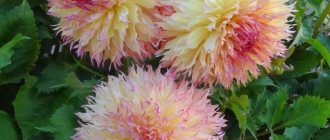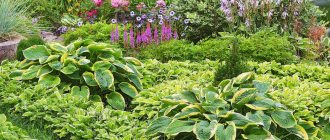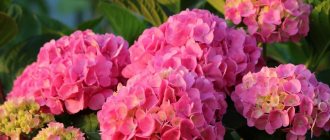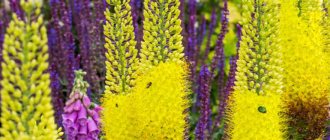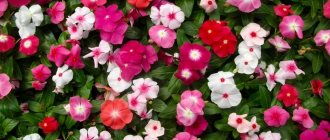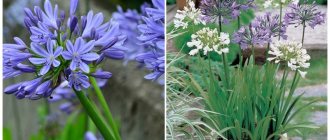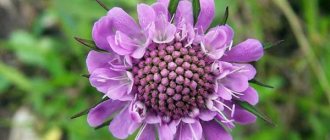- June 19, 2019
- garden plants
- Anastasia Efremenkova
In this article we will talk about the features of a plant such as bergenia, planting and caring for it in the garden. In general, bergenia is a herb and belongs to the Saxifraga family. The herb also has a second name - bergenia. This perennial herb can be found in its natural environment in China, Korea, and Central Asian countries. It prefers rocky soil, so it most often grows in rock cracks. Bergenia entered the culture in the 18th century. It received its second name from the botanist Carl August von Bergen. Now only 10 species of this grass are known, but breeders have managed to develop many more varieties. So, next we’ll find out what care and planting of bergenia in open ground include.
general description
Bergenia can be presented in the form of both perennial and annual plants that have a horizontal root system and can reach a height of 35 centimeters. The leathery leaves of bergenia are collected in basal rosettes; in almost all species, the leaves are dark green and located on long petioles. The flowers are goblet-shaped. The color palette is not too diverse. The most common flowers are white, pink or red. They are collected in paniculate inflorescences. Bergenia blooms begin around the end of May or early June, depending on the climate of the area. Please note that up to 120 flowers can be collected in one inflorescence. Bergenia also has a fruit - a seed capsule.
Quite often, bergenia is used in landscape design. This plant goes especially well with stones and crops such as phlox and hosta. Let's move on to the features of caring for and planting bergenia in open ground.
Brief description of cultivation
- Landing . Bergenia seeds are sowed for seedlings before winter in boxes, seedlings are picked in the first days of June, and seedlings are planted in open soil in early August. If desired, the most powerful seedlings can be planted directly into the garden in early June, without diving.
- Bloom . Depending on the species, flowering times may vary; some of them begin to bloom in the last days of April. Flowering duration is approximately 6 weeks.
- Illumination . Grow in a slightly shaded area, but an area with bright, diffused light is also suitable.
- Soil . Suitable soil should be loose, light, moist and slightly alkaline.
- Watering . If the season is dry with little rain, then the flowers are watered for the first time during the formation of buds, then when they bloom, and the last time after 15–20 days. If it rains regularly, then there is no need to water the bergenia.
- Fertilizer . The first feeding is in early spring after the bush is pruned, the second is 15 days after the bergenia fades. For feeding, mineral complex fertilizer in liquid form is used.
- Reproduction . By dividing the bush and seed method.
- Harmful insects . Nematodes and slobbering pennies.
- Diseases . Ramulariasis.
- Properties . In such a herbaceous perennial, the rhizome has healing properties. Products made from it have a hemostatic, antimicrobial, astringent, anti-inflammatory, wound-healing and diuretic effect.
Types and varieties of bergenia
Below we will describe the types and varieties of bergenia that can most often be found in cultivation.
- Badan Strechi. It has oblong, ovoid leaves. Small teeth can be seen along the edges of these leaves. The length of the leaf is 8-10 centimeters, and the width is only 3-5 centimeters. Peduncles can reach 40 centimeters in height. They bear white or lilac-pink flowers, which are collected in racemose inflorescences. Among the best varieties of the species, Alba, Belvedere and Beethoven should be highlighted. Belvedere is different in that it grows in height to only 20 centimeters. And its white flowers gradually, during the flowering process, become pink.
- Bergenia thickleaf. Planting and caring for thick-leaved bergenia does not cause any problems. In addition, this type is most often used in medicine. It differs from other species in that it has two types of shoots: leafless flowering and vegetative rosette. On the vegetative shoots there are rather large leathery leaves that have an obovate shape. Their bright green color turns fiery red in autumn. The flowers are bell-shaped and collected in dense inflorescences. The best varieties are considered to be: Hydroruspe (a fairly tall plant - up to 60 centimeters, blooms for almost two months), Purpurea (the shrub can reach half a meter in height), Senor.
- Bergenia cordifolia. This is a variety of thick-leaved bergenia. It has rounded dark green leaves. Lilac, bell-shaped flowers are collected in racemes. Flowering begins in May. This plant came into cultivation in 1779.
- Hissar bergenia. One of the rarest species. It has rosette leaves, obovate in shape, covered with thick cilia along the edges. The flowers are located on peduncles 20 centimeters long. 6-8 white or pinkish flowers are collected in racemose inflorescences.
- Bergenia hybrid. This species includes varieties that are most often found in cultivation: Abenglut (its bright green leaves acquire a bronze-brown tint by autumn and has double flowers); Frau Holle (distinguished from other varieties by its snow-white flowers); Morgen Rothe (this variety blooms twice per season); Baby Doll (has beautiful flowers that are pale pink at the beginning of flowering and later become dark cream).
What kind of flower is bergenia?
Bergenia (bergenia) is a herbaceous plant with a creeping rhizome, thanks to which it grows quickly and covers unsightly areas of the garden with its large rounded leaves. It successfully displaces weeds, not only with its rhizome, but also with its spreading rosette that creates dense shade. At the same time, bodan is not tall - usually up to 40 cm, and gets along well with other ground cover plants and flowers.
Bodan is decorative all year round:
- From May to early summer it is decorated with panicles of inflorescences. The height of the peduncle and the shade of the corollas depend on the variety; the main colors are: white, pink, lilac, violet. The panicles of bergenia look good against the background of forget-me-nots, tulips, doronicum and other plants that bloom at the same time.
Bergenia gets along well with other plants in the flowerbed
- In the summer, after flowering, the wide leaves combine beautifully with the sword-shaped leaves of the iris, openwork of the fern, carved leaves of the volzhanka, etc.
- In the fall, having been exposed to the first frosts, rosettes of bergenia themselves turn into flowers, turning crimson, lilac or purple. Interestingly, the leaves of many varieties remain alive even under snowdrifts.
After the first frost, the bergenia itself becomes bright, like a flower.
Over time, the old leaves die off, undergo natural fermentation and turn into healing tea. For medicinal purposes, it is the old, already dried, brown leaves that are brewed. In Altai, the drink is called Chigir tea. It has a tonic and antibacterial effect, normalizes blood pressure, and removes kidney stones.
The lower, dried leaves are collected for tea.
Popular types and varieties
Vergenia crassifolia is a thick-leaved bergenia, also known as early flower, Mongolian and Chagyr tea. The species is widespread in the mountainous and taiga areas of Siberia, and in Altai it is a technical medicinal plant. Also, thick-leaved bergenia grows wild in China, Korea, Mongolia, and Kazakhstan.
The leaves of this species are succulent, green, obovate in shape, and turn purple-red in autumn. But they appear in the spring only after the peduncle has grown. The corollas at its top are collected in dense inflorescences, depending on the variety they are pale pink (Hiderruspe variety), purple (Purpurea), lilac (Senior). The height of the thick-leaved bergenia bush is 40–60 cm; it blooms in May-June for 3–4 weeks.
Video: what thick-leaved bergenia looks like and how it is useful
Vergenia cordifolia, or heart-leaved bergenia, native to Altai, is a variety of thick-leaved bergenia. The height of the rosette is 40 cm, it blooms for 3 weeks in May with pink or purple inflorescences inclined to the ground. The leaves of this species are dark green and overwinter under snow until spring.
This bergenia got its name for the shape of its leaves.
Vergenia ciliate is a ciliated bergenia, common in forests and mountain ledges of the Himalayas, in Tibet, for this it is called Himalayan. The leaves in rosettes are almost round, up to 35 cm in diameter, covered with cilia along the edges and back, and often remain smooth on the front, in the center of the leaf. In our climate, the rosettes freeze out in winter, but grow back in the spring. Bergenia blooms with pale pink corollas.
The leaves and petioles of the ciliated bergenia are covered with pubescence
Not a single variety of bergenia is registered in the State Register of Breeding Achievements of the Russian Federation. In the official sale you can find seeds and seedlings called not varieties, but species: cordifolia, thick-leaved, ciliated, bergenia Cordifolia (cordial), heart-leaved bergenia “Mongolian tea”, etc.
Sowing seeds
It is recommended to sow bergenia before winter. Choose a suitable box and fill it with flower soil. Next, it is necessary to make grooves in the soil, the depth of which should not exceed five millimeters. The distance from one groove to another should be three centimeters. After they are ready, you should spill them with warm water, and then lay out the seeds and immediately sprinkle them with soil. After planting, the box must be taken outside and placed under the snow. At the beginning of March, it will need to be brought indoors and placed in partial shade. The air temperature in the room should not fall below +18-19 degrees.
2.When the bergenia blooms
In early flowering species, the first buds may appear as early as the end of April, while many plants bloom in the first half of summer.
Bergenia has a fairly long flowering period - the buds decorate the plants for 3 - 4 weeks. There are also record holders for the duration of flowering - plants of some varieties can bloom continuously for up to 2.5 months.
If you remove inflorescences with fading buds in time, then at the end of summer - beginning of autumn you can observe re-blooming, although it will be less abundant.
↑ Up,
Bergenia seedlings
Within three weeks after you bring the box of bergenia into the house, the first shoots will appear. Caring for bergenia seedlings is not difficult. It is necessary to periodically loosen the soil and carry out timely watering. But remember that you need to moisten the soil only when its top layer is dry. Also, do not forget to ventilate the room and remove weak shoots so that they do not interfere with the development of stronger ones. Sometimes it happens that a green crust appears on the surface of the earth. It indicates that the root system receives too much water, and because of this, oxygen ceases to flow to the roots.
Fertilizer and fertilizing of bergenia
The plant is very responsive to properly selected fertilizing. Before and after bergenia blooms, it is recommended to use mineral fertilizers. 2-3 weeks after flowering, you can feed the plant: fertilizers in this case activate the process of growing and aging of the leaves, which at this time are just beginning to change their color.
The plant should be fed with mineral compounds
Bergenia pick
In May, the first picking of bergenia seedlings is carried out. They are transplanted into a new box. The distance from one seedling to another should be 5-7 centimeters in a row. But the distance between the rows is 15 centimeters. Decide in advance when you will plant bergenia in open ground. Because a few weeks before this, you should start hardening off the seedlings. The box with seedlings is taken out onto the loggia or balcony. It is better to start with one hour of stay there, gradually increasing the time. When the seedlings have been on the balcony for a day, you can safely start planting them in open ground.
Growing bergenia from seeds
Sowing
Sowing of bergenia seeds is carried out before winter. To do this, the box is filled with a flower soil mixture, in which shallow grooves (about 0.5 cm) are made; the distance between them should be at least three centimeters. The grooves are shed with water, the temperature of which is slightly above room temperature, after which the seeds are evenly distributed in them and sealed. Take the crops out into the garden and bury them in the snow. They bring the box into the house in the first days of March and place it in a shaded, cool (18 to 19 degrees) place.
Growing seedlings
The first seedlings should appear after about 20 days. The seedlings must be watered in a timely manner as the top layer of the substrate dries, systematically loosen it, and also, if necessary, thin out the grown plants and regularly ventilate the room where the seedlings are located. If a green coating or crust appears on the surface of the substrate, then you should very carefully loosen the substrate, since this causes very poor oxygen supply to the root system of the plants. And a crust appears as a result of too much watering.
Picking seedlings
The picking of bergenia seedlings is carried out in May. For this, a larger box is used, and a distance of 50 to 70 mm should be maintained between seedlings, and the distance between rows should be about 15 centimeters.
When about half a month remains before transplanting the seedlings into the garden, you should begin hardening them off. To do this, the seedlings are taken out into fresh air every day, and the duration of this procedure is gradually increased. As soon as the seedlings can be in the fresh air around the clock, they are transplanted into the garden.
Disembarkation time
Caring for and planting bergenia plants should not cause you any difficulties. By following simple rules, you can easily achieve success. In general, experienced gardeners recommend planting bergenia at the end of August, since the seedlings develop rather slowly. But if you see that you have strong seedlings, you can plant them in June. As for everyone else, it is better to carry out another pick and let the seedlings grow and get stronger. Bergenia seedlings will be completely ready for transplanting into open ground in August.
The healing properties of elephant ears
All parts of Badan are used for medicinal purposes. The plant is used to provide various effects.
- Antipyretic;
- Antibacterial;
- Anti-inflammatory;
- Diuretic;
- Healing;
- Anti-stress;
- Antitumor;
- Antimicrobial and hemostatic (from leaves).
Tablets are made from the roots to treat diseases of the uterus and oral cavity. In folk medicine, the use of this remedy is wider.
- Hypertension;
- Pneumonia, pulmonary tuberculosis;
- Pain in the head area;
- Diarrhea, gastrointestinal diseases;
- ENT diseases;
- Rheumatism;
- Kidney diseases.
Disembarkation rules
So, how do you plant bergenia in the garden and care for the planted seedlings?
The root system of bergenia is quite weak and is located horizontally. Therefore, for planting seedlings, you should choose loose and light alkaline soil. Quite often it happens that the roots of the bergenia begin to peek out from under the ground. You should think about this in advance, since in this position they may overheat in the sun. To prevent this from happening, you should choose a shaded area for planting bergenia. It is better if it is the northern, northeastern or northwestern part of your site. If you cannot plant bergenia in such a place, then immediately after planting, lay a layer of mulch in the root zone. This will allow the soil to dry out more slowly, and the root system will be protected from sunlight. Be sure to take into account the fact that moisture should never stagnate in the roots of bergenia. He can't stand it.
So, he proceeds directly to planting bergenia. It is necessary to make holes in the soil, the depth of which should be 6-8 centimeters. It is better to arrange them in the garden bed in a checkerboard pattern. The bottom of each hole should be covered with a layer of sand, which will act as drainage. The seedlings are transferred into the holes directly with a lump of earth and immediately dug in. Immediately after planting the seedlings, it is necessary to water the beds. The development and growth of bergenia is quite slow, so you will have to be patient. In the first two years there is no need to wait for flowering. Typically, bergenia blooms in the fourth year after planting in open ground.
Planting bergenia in open ground
What time to plant
Planting and growing bergenia in your garden plot is relatively simple. The fact is that this culture is unpretentious and frost-resistant. Seedlings are planted in open ground in the first days of August. However, some gardeners believe that seedlings should be planted in the garden at the beginning of summer, but there is no need to pick them. But what most often happens is that most of the plants turn out to be too weak to grow in open soil. In this regard, only the strongest and most developed bushes can be planted in open ground at the beginning of summer, and the rest are picked and grown at home until August, and only then are they transplanted into the garden.
Landing Features
The rhizome of bergenia is very weak and is located horizontally. In this regard, for its cultivation, areas with loose, light and moist soil of a slightly alkaline reaction are chosen. Often the plant's rhizome protrudes from the soil, which can lead to its overheating in direct sunlight. In this regard, a suitable site should be located in a slight shade on the north-west, north or north-east side of the garden. If you still choose a sunny area to plant bergenia, then you will need to cover the surface of the soil around the bushes with a layer of mulch, which will help prevent the rhizome from overheating and will also slow down the drying out of the soil. When choosing a site, you need to take into account the fact that the plant reacts extremely negatively even to short-term stagnation of liquid in the root system.
Planting holes are made in the selected area, the depth of which should be from 60 to 80 mm. They are placed in a checkerboard pattern of 40x40 centimeters. A handful of sand is poured into the bottom of each hole. After this, the plants are carefully transferred into them; you need to take them along with a lump of earth, fill the holes with soil. Planted plants need to be watered.
You must be prepared for the fact that the development of such a plant is extremely slow. The first flowering of bushes grown from seeds will occur only in the third or fourth year.
Bergenia thickleaf: planting in open ground. How to plant bergenia in spring
Rules of care
Usually, planting cordifolia bergenia and caring for it do not cause any problems for the gardener, but this also applies to other types and varieties of this plant. Since bergenia is an evergreen herb, after winter, when the snow melts, damaged leaves remain on it, which should be removed in the spring. You also need to remove shoots that have grown too much or have been damaged. After pruning, complex mineral fertilizer should be applied so that the bergenia can regain its strength and begin to grow. The next feeding will be needed two weeks after the end of bergenia flowering; during this period the plant also needs to regain its strength. Because after flowering, new leaves begin to appear on it. It is better to use Kemira combi as a fertilizer. The solution is easy to prepare. For ten liters of water you will need only one tablespoon of fertilizer. This amount is usually enough for two square meters of flower bed.
A mandatory point when learning the rules for caring for and planting bergenia in open ground is watering. As already mentioned, bergenia does not tolerate waterlogging of the soil, so it needs to be watered only at certain periods. The first time is when the buds begin to form, then when flowering begins, and the third time two weeks after flowering ends. However, even this schedule should be followed if the summer turns out to be dry. If there has been rain, then there is no need to water the bergenia. In the wild, bergenia itself is able to protect its roots. This is possible thanks to dying leaves that remain in the root zone. But in culture, it is customary to remove such leaves in order to maintain the decorativeness and beauty of the area where the plant is planted. When removing such leaves, you need to get rid of the cuttings. But the root system will be perfectly protected by a layer of mulch laid directly under the bushes.
As for planting bergenia seeds, caring for seedlings was described above. There are no difficulties in this option either. However, gardeners prefer to propagate the plant by dividing the bush.
Caring for bergenia in the garden
Most often, if the rules of agricultural technology are followed, growing bergenia in open soil does not cause any special trouble to the gardener. In the spring, after the snow cover has melted, you need to cut off all the foliage from the bushes that was damaged during the winter. Also at this time, heavily overgrown stems are pruned and fertilized with complex mineral fertilizer. The plant is fed again half a month after the end of flowering, at which time new foliage should begin to grow. A solution of Kemira-combi fertilizer is suitable for feeding bergenia (1 tablespoon per 1 bucket of water). For 1 square meter of flower bed, take 5 liters of this solution.
Watering
In order for a flower to grow and develop normally, it must be watered correctly. The bushes are watered the first time after the buds begin to form, the second time during flowering, and the third time 15–20 days after the plants have finished flowering. However, it is necessary to water the bergenia only if the season is dry. If it rains regularly, then the flowers will have enough natural precipitation.
The roots of such a flower protect its lower leaf plates from overheating and drying out in nature, which eventually die and fly off. But when growing in the garden, in order to preserve the decorative appearance of the bushes, the leaf plates that have begun to die are torn off along with the petioles, and the soil surface is covered with a layer of mulch.
Reproduction by dividing the bush
Bergenia can be propagated not only by seeds, it can also be done by dividing the bush. An overgrown bush forms young rosettes with its own root system, which is located very close to the soil surface. That is why it is very simple to dig up and transplant a young rosette without injuring the parent plant. Only a healthy, well-developed, middle-aged bush with large leaf blades can be divided, and the leaf rosette is separated along with the heel. Make sure that there are three or more buds on each section of the rhizome. The division is carried out after the bushes have flowered: in May–August. On the cut rosette, only 2 or 3 of the youngest leaf plates should be left, and all the rest should be torn off. They are planted in pre-prepared planting holes, and they need to be buried 30–50 mm into the soil, and the distance between the divisions should be from 30 to 40 centimeters. The planted cuttings quickly take root. During the first year after transplantation, the rosette grows foliage, and the young bush will bloom only after the 2nd or 3rd year of growth.


